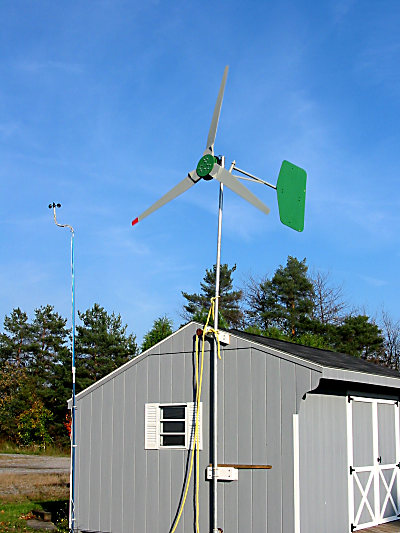And here is the anemometer flying on its own pole to the left of the mill -

To summarize: I got a cup set from our host, used a tiny 3 phase servo motor as the sensor, put an op amp comparator on one phase to generate a square wave. That's all potted right under the cups and I run three wires for power and signal return up the pole and into the mill shed. In there, it's connected to a little microcontroller that converts the pulses (rpm) into wind speed.
The perspective throws it off a little but the height is within a few inches of the center of the blades; the offset at the top of the pole puts it about three feet away from the blades at their closest approach. BTW: the pole itself is 16 foot "pool cleaning pole" I got at Sam's club for $12 USD.
Haven't seen much wind at all but here's what I've found out so far:
Unloaded, my mill makes about 20 RPMs per MPH of wind. That's pretty much what I expected from entering a TSR 7, 10' diameter blade into Alton's wind calculator. We didn't get enough wind today to see what the MPH/RPM relationship looks like with loaded blades.
Some notes on mill performance:
What I did learn is that the mill blades will spin in a 2 MPH wind although it takes a little over 3 MPH to get them started.
I wish the anemometer had been up this weekend when the front moved through but it wasn't. I did see the mill making 40 to 50 amps for short periods of time; that's way over a kilowatt and pushing 1.5KW. It was the first time that my dump resistors were uncomfortably warm to the touch. (The dump controller was working great; thanks everyone for help with that!)
That's too many watts.
I'd previously added to the tail because the mill was being blown off-wind prematurely (although it was limiting itself nicely to about 33 amps, about 900 watts). I guess that extra tail, a piece of thin plywood clamped on with two c-clamps, added too much weight. I'll want to make a bigger tail and keep the weight about the same but get up on the roof to take the extra tail off while it was fairly calm today.
... am still working on a real tower but not that quickly.
- Ed.